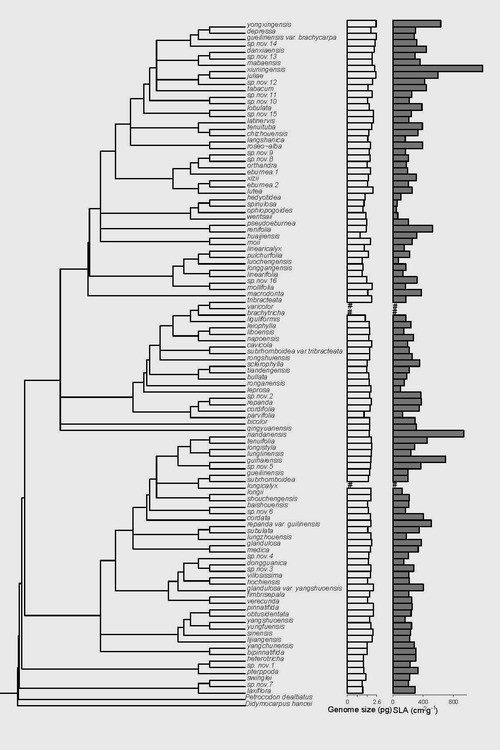华南植物园首次报道报春苣苔属56个物种的染色体数目
中国科学院华南植物园研究员康明等重建了报春苣苔属的系统发育关系,首次报道了56个物种的染色体数目。相关文章发表于2014年2月17日的《New Phytologist》杂志上。

报春苣苔属植物基因组大小(genome size)和比叶面积(SLA)在系统发育树上的分布
基因组大小即物种单倍体的DNA含量,是一个物种基本的生物学特性,也是进化生物学领域的重要理论问题。物种基因组大小的进化包括适应性和非适应性等多种机制,但不同机制在基因组大小进化过程中的重要性却一直存在争议。
喀斯特地区是我国植物多样性和特有性的热点区域,迄今为止没有开展过该地区植物基因组大小变异及其进化机制的研究。报春苣苔属(Primulina)是一个我国华南喀斯特地区物种多样性异常丰富且高度特有的类群,又由于该属植物具有强烈的生境专化性,因而是一个研究基因组大小进化及环境适应的理想系统。
中国科学院华南植物园研究员康明等在广泛野外调查和取样的基础上,重建了报春苣苔属的系统发育关系,采用流式细胞仪报道了该属植物100多个物种234个居群的基因组大小和比叶面积(SLA),并首次报道了56个物种的染色体数目。
在此基础上,采用系统发育比较生物学理论和方法,研究了基因组大小进化模式及其与生态环境因子的关系。研究结果发现,报春苣苔属植物的基因组大小变异受到强烈的系统发育影响;同时基因组大小与叶片功能性状(比叶面积)和纬度梯度下的气候因子显著相关,表明报春苣苔属植物的基因组大小变异具有环境适应性,基因组小的物种可能由于其对DNA合成必须元素(如N、P)的需求较少因而在低纬度的干热喀斯特生境中更具选择优势。这些研究结果表明报春苣苔属植物基因组大小的进化是中性进化和适应性进化共同作用的结果。
该研究结果已在线发表在国际学术期刊New Phytologist(doi: 10.1111/nph.12726)上。研究得到了国家自然科学基金项目(31270427)的资助。
原文摘要:
Adaptive and nonadaptive genome size evolution in Karst endemic flora of China
Ming Kang, Junjie Tao, Jing Wang, Chen Ren, Qingwen Qi, Qiu-Yun (Jenny) Xiang,Hongwen Huang
Genome size variation is of fundamental biological importance and has been a longstanding puzzle in evolutionary biology. Several hypotheses for genome size evolution including neutral, maladaptive, and adaptive models have been proposed, but the relative importance of these models remains controversial.
Primulina is a genus that is highly diversified in the Karst region of southern China, where genome size variation and the underlying evolutionary mechanisms are poorly understood. We reconstructed the phylogeny of Primulina using DNA sequences for 104 species and determined the genome sizes of 101 species. We examined the phylogenetic signal in genome size variation, and tested the fit to different evolutionary models and for correlations with variation in latitude and specific leaf area (SLA).
The results showed that genome size, SLA and latitudinal variation all displayed strong phylogenetic signals, but were best explained by different evolutionary models. Furthermore, significant positive relationships were detected between genome size and SLA and between genome size and latitude.
Our study is the first to investigate genome size evolution on such a comprehensive scale and in the Karst region flora. We conclude that genome size inPrimulina is phylogenetically conserved but its variation among species is a combined outcome of both neutral and adaptive evolution.

